Tamworth Rugby Union Sporting Club
The Tamworth Rugby Union Sporting Club plays three men's team and one women's team in the New England Rugby Union in northern NSW.
The NERU is an affiliate of the NSW Country Rugby Union. The club is based at Rugby Park, Marius Street, Tamworth, NSW.
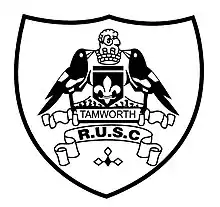 | ||
| Union | New England Rugby Union | |
|---|---|---|
| Nickname(s) | Magpies | |
| Founded | 1880 and 1952 | |
| Disbanded | 1919 | |
| Location | Tamworth NSW | |
| Ground(s) | Rugby Park, Marius Park (Capacity: 2000) | |
| President | Mitchel Hanlon | |
| Director of Rugby | Peter Burke | |
| ||
| Official website | ||
| www | ||
Origins
The nearest clubs to the Tamworth club were located in the Newcastle district so matches were organised on an ad hoc basis. The Main North Railway had been extended to Tamworth in 1878 and to Armidale in 1883. Its construction no doubt aided the development of the rugby code simply because teams could travel with speed and comfort. Inter district competition assisted with the promotion of the game as did the promotion of a shorter working week so workers could enjoy recreational activities. Saturday afternoons became available for activities such as organised sports.
There is a report of a game to be played against the Maitland Albions in 1880[1] whilst the Tamworth Rugby Club is listed in the report of the Southern Rugby Union of 1880[2] and again in 1881.[3] The Tamworth Rugby Club appeared in the list of clubs that formed the New England Branch of the New South Wales Rugby Union. Tamworth is listed as one of the 35 clubs subscribed to the Southern Rugby Union at their AGM of 1882.[4] The Armidale Football Club is reported as being formed on 12 May 1880 with games to be played under the rugby rules.[5]
The Newcastle Football Club in 1891 visited Tamworth with a scratch team and had a pleasant time winning against the local team 10 points to 3.[6] Also in 1891, a combined Armidale team won against a local Tamworth team by 3 points.[7] The Tamworth Acme Club combined lost 0–6 against a team from the newly formed New England Rugby Union in 1893.[8]
The NERU was formed in 1892[9][10] with a subsequent formation meeting in 1893.[11] Its listed member clubs in 1894 were: Uralla, Armidale, Gunnedah, Hillgrove, Quirindi, Tamworth and Walcha. Tamworth-based teams were Acme, Tamworth and Royal Standard. Rugby continued to be played around Tamworth and Armidale with teams leaving and joining the competition. The Newcastle Morning Herald and Miner's Advocate reported a crowd of 800 people attending the rugby union ground to watch two games between 15 players representing the three Tamworth clubs and the first 15 of the Newcastle Club.[12]
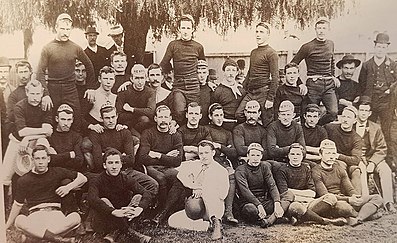
The NERFU championship teams from 1892 to 1901 are:
- 1892 Armidale d Albion (Armidale) 12-0
- 1893 Armidale d Tenterfield 3-0
- 1894 Albions (Armidale) d Acme (Tamworth) 12-0
- 1895 Gunnedah d Armidale 12-6
- 1896 Gunnedah d Arforma (Armidale) on forfeit
- 1897 Albions (Armidale) d Gunnedah 9-0
- 1898 Gunnedah d Federals (Armidale) 16-8
- 1899 Federals (Armidale) d Tamworth 14-7
- 1900 West Tamworth d Albions (Armidale) 8-0
- 1901 Carlton (Armidale) d West Tamworth 9–3.[13]
The mood to move away from the NERU is expressed in an article from 1900 where Tamworth Club at its annual meeting passed the following resolution:
"That the secretary communicate with the Tamworth West, Werris Creek and Manilla Football Clubs as to the advisability of not joining the New England Rugby Football Union unless it was guaranteed that the final match be played in Tamworth."
it was felt that the local clubs had supported the NERU for a number of years but that a final match had never been played in Tamworth.[14] Central North (Tamworth) was subsequently formed and applied to affiliate with the NSW Rugby Union in 1903.[15]
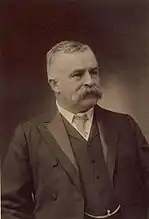
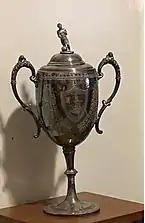
The Central Northern Rugby Union Cup was won by the North Tamworth club in 1903, 1904 (d Murrurundi 11-0[16]) and 1905 (d Murrurundi 16–0.[17] It was presented by CM Oliphant Esq to the club's captain W Jones. The 1904 Central North competition involved the North Tamworth, East Tamworth, West Tamworth, Manilla, "our Boys" (Moonbi) and Quirindi clubs. The Sawers Shield was donated by William Sawers MHR for best team in Central North and New England Rugby Unions. William Sawers was one of the few non-Armidale resident to hold a position on the NERFU committee. He was president of the Tamworth Rugby Club in 1896 and a vice-president of the NERFU. he was the inaugural member of the new New England electorate in the first Federal parliament.
A newspaper report from 1912 states the East Tamworth club's colours as chocolate and pink and narrowly winning the premiership by prevailing over Walcha in the last game of the season with a one-point victory.[18]
In 1913, in spite of the smallpox epidemic which was then raging, the New Zealand Maoris played the Northern Districts team at Tamworth winning 29–8. All players had to have smallpox vaccinations prior to playing.
Prior to the outbreak of World War 1, two New South Wales country matches were played by the visiting All Blacks, the last for six long years because the New South Wales Rugby Union decided to discontinue all senior games for the duration and to give maximum support to the war effort. In contrast to the professional game which continued to play at all levels.
The Split and World War 1
In 1911, the East Tamworth Club wrote to Central North Rugby Football stating it strongly resented the move of some players to the new code.[19] An article in the Tamworth Daily Observer of 29 May 1913 wrote about the conflicting rugby codes wanting use of No.1 oval for competition games.[20]
The Central North Rugby Union annual general meeting on 30 March 1914 indicated a reasonably healthy commitment to the game.[21] Four clubs were affiliated with the union in East Tamworth, West Tamworth, Attunga and Walcha. There were visits from six teams: Maoris, South Sydney, Tenterfield, Muswellbrook and St James (Western Suburbs) with zone teams sent to Armidale and Muswellbrook. An inter zone game between the winners of the CNRFU (West Tamworth) and the NERU (South Tamworth) resulted in a 6–5 win to South Armidale.
The advent of WWI saw many rugby union competitions dissolve for patriotic reasons and lack of numbers. An Inverell Times report of 24 April 1915 stated that the North West Rugby Football Union took the view that anyone who was able to train for football should enlist and resolved to abandon all competition games. Numbers were lost to the war effort or to the rival league code. Rugby league continued to play and gained a strong foothold as a result. A meeting of rugby enthusiasts meeting at Nail's Criterion Hotel on 16 June 1916 resurrected the CNRU.[22] The Manly Rugby Club visited Tamworth later in the month and played games against the Tamworth Union 15.[23] The following month saw Tamworth and Manilla play a match with funds raised devoted to a local patriotic fund.[24]
Despite these intermittent efforts, the 1914-18 war years were hard on the rugby code. An example of the effect the league movement was having on rugby is the AGM notice for the New England Football Union of 1919 where consideration would be made as whether the union should cease its activities in favour of the league game.[25] Fortunately the NERU rallied and Armidale continued to play rugby whilst all other centres made the switch.
The Revival - 1952
Rugby came back to Tamworth in 1952 as a result of a conversation at Martin Place, Sydney between Doug Campbell and John Carroll, a member of NSW Rugby Union. Both Doug and John were members of the Northern Suburbs Rugby Club. When John heard Doug was coming to Tamworth to live he suggested attempts should be made to form a rugby club to join up with Armidale and Walcha who were both playing in the New England competition.
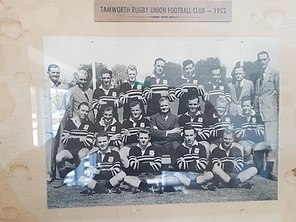
An advertisement was placed in the Northern Daily Leader calling a meeting to see what interest to form a club. About a dozen people attended. All were fellows who had played rugby in other places with one being former Gordon player Stan Blake.[26] The meeting resolved to form the Tamworth Rugby Union Club. That was in late 1951.[27]
Application was made to enter a team in the 1952 New England competition.[28] By 1952, the NERU teams were Armidale City, University, Teachers College (2 teams), Walcha and Inverell.
The first group of players was made up of former rugby players as well as some players who had never played the game before. A lot of them were employees of the NSW Department of Main Roads and Bank of Australasia. As was common for the time, most of the players had to work Saturday mornings which would prevent them from travelling to away games. Jeff Jefferies, who was manager of the bank and became the first President of the reformed club, gave Saturday mornings off to any fellow who would play rugby. Ted Wood of the NSW Department of Main Roads did the same. Ted was the man who designed the old club house and whose name is on the foundation stone there.[26]
In 1952 games were played against Walcha, Armidale City, New England University, Armidale Teaches College, Guyra and Inverell. The Walcha club had only been reformed in 1950 after a 20-year hiatus when Doug Laurie placed an notice in the Walcha News of a meeting on the 28 January at the Literary Institute to consider "...the formation of a Rugby Union Football Club". The Walcha club brought two teams to Tamworth during a bye weekend. The club contained multiple zone and Country representatives such as Don Lisle who scored four tries in their 34–0 win over Tamworth. Don had played for the New England, NSW Country and NSW teams in 1950. Another Walcha player Peter Fenwicke went one better and went on to play for Australia in 1957.[29]
Some Saturdays, it was hard to round up 15 players even after a round of the pubs. Needless to say the standard of play was not all that good and in that first year the team suffered some terrible hidings sometimes by scores approaching 100. The first try was not scored until well into the 1953 season that was by Doug Schultz in the snow at Armidale.[26]
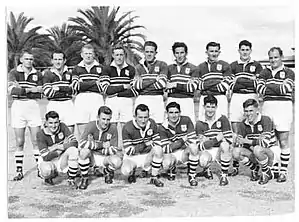
In 1953 Tamworth was having annual games with the Merewether Carlton Rugby Club from Newcastle and were invited to play a curtain raiser to the touring Fijians, the problem was to determine how good we were as to whether we played the first game or the main curtain raiser. There were a couple of former Newcastle rugby players who were playing with the East Tamworth league side as rugby was not played when they arrived in Tamworth. In those days you could not play rugby union if as a league player you had been paid. You had to get statutory declarations and other evidence before you could go back to rugby union. With some deft paper work, these two very good footballers played with our team and we nearly won the main curtain raiser against Merewether Carlton.
By 1954 player numbers had increased so that a second grade side was playing and in 1955 with Ian Sinclair as coach the first grade side won the New England competition at Armidale against Glen Innes. Ian had to play as two forwards were injured.[26]
In the 1950s and early 1960s, Tamworth Rugby hosted games at Tamworth's No. 1 oval. Touring teams include the Fijians in 1954 winning against New England in front of 6500 spectators 37–14.[30] The New England team played well but was outclassed by the tourists. The British Lions beat Combined Country 27–14 in 1959.[31] The 1959 Country team had four players who wore the Wallaby colours; Peter Fenwicke (Walcha), Bill Gunther (Molong) and Jim Lenehan and Beres Ellwood (both from Wagga Wagga). Other representative games were held against the Springboks, the NZ Services side and later the New Zealand All Blacks.
1955 saw the club build its first clubhouse on land opposite Viaduct Park. Its foundation stone is inscribed Tamworth Rugby Union Sporting Club. This was groundbreaking as many country clubs did not have a dedicated club house.
In 1956 the NERFU accepted new nominations for first and second grade from Quirindi, Gunnedah and Kootingal-Bendemeer. These additions meant that distances travelled by the southern zone teams became a problem. The compromise solution saw the New England zone split into northern and southern zones in 1957 with each zone playing two rounds of matches before uniting in a third round to decide the competition. The southern zone teams included Tamworth, Walcha, Quirindi, Gunnedah and Kootingal-Bendemeer.
The revived Central North zone evolved from the old Southern Zone in 1958 under the approval of the NSWRU. A meeting had been held in Tamworth in November 1955 to discuss the formation of a new Southern Zone competition in New England.[29] A further meeting was called by the Tamworth club in November 1956 to discuss football arrangements for 1957. Many clubs were upset by the stop-start nature of the NERFU competition when University and Armidale Teachers College holiday breaks meant players were not available to field teams.
Teams in the Tamworth-based competition had played in the southern zone of the NEFRU for several years. In early 1958, the Walcha, Tamworth, Gunnedah and Quirindi clubs applied to the NSW Rugby Union for recognition as the Central Northern Union. Despite some opposition the application was granted.
Prior to 1962, there had been only five clubs fielding first grade teams in the central North Rugby Union district. A three-round competition had been customary, with Walcha, Quirindi, Tamworth and Gunnedah playing the full season; the then newly formed Moree would play in the second and third rounds.
This period saw other towns now playing in Central North formed their own clubs as well as the establishment of the Tamworth Pirates Rugby Club who evolved out of the Tamworth Country based at Kootingal.[26]
The 1960s and 1970s
Coming into the 1960s, many of the senior Tamworth players could see that they were keeping younger players out of the game, so they decided to form another club. Tom Jackson, Geoff Quninlan, Lex Wiseman, Geoff Goodacre and Ron May formed the core of the Pirates Rugby Football Club. Other players in the club's first year came from Barraba, Kootingal, Army CYO and of course, Tamworth. As they were of somewhat advanced age, they decided that the new Pirates Rugby Club that they formed would be for fun rugby only. The rugby game would not be taken too seriously, with training to be minimal, and social interaction was to be the most important aspect of the club. This culture survived for many years in the new club, while the new group of young players at the Tamworth Club did very well in the match aspect of the game.
Among these players were many other well-known Tamworth identities, including John Lyons, Brian Thompson, Brothers Col and Doug Fraser, John "Bo" Boschetti, Ken Noble, Doug Smith, Doug Ashford, Brian Mansfield (later to become a Wallaby), and many more.
Other clubs to join include Narrabri (1964) and Barraba (1964). The Inverell club had reformed in 1951 but the year it joined Central North is not known.
1969 the Fijian national team revisited the region and played the New England team in front of 7000 people at No.1 oval winning the game 37–14.[32]
The 1970s ushered in the "Somerton Era", with often more than half of the First and Reserve Grade teams made up with mostly sons of the soil from the Somerton area. Tom and Bob Woolaston, Bob and Jim Brown, Graham Baldwin, Brian Heyman, Greg Hamilton, John Chaffey, Ty Atkinson, Alistair Fenwicke, John Barnier, and later Peter Norris, Gavin Hombsch, Alex and Andrew Draper, etc. This was a period of great spirit within the Club because of the closeness of the players to each other, shown by the way all helped in the running of the club. Sunday morning was clean-up time after a home match, and most players from Somerton and elsewhere attended to help remove the mess and enjoy a bar-b-q and beer afterwards.
The standard of play in Central North began to improve in this period with the appearance of the first Australian Rugby Manual, and the arrival at Tamworth of some ex-Sydney Grade players in Bill Feggans (NSW Representative), Peter Horsefield and Vince Symons strengthened the ranks of players and later Coaches. However, the great Narrabri teams of the Seventies steam-rolled all before them in the competition.[33]
The 1980s and 1990s
The 1980s were a period of building in the Tamworth Club based largely on players coming through from the newly formed Under 19 Competition, plus another influx of ex-Sydney Grade Players like Stefan van Aanholt, Stu Keller and Chris Collins.
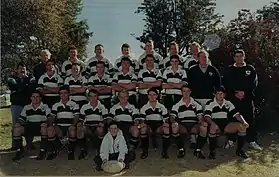
Tamworth enjoyed a golden era in the Nineties winning several premierships in all grades, based on the former Juniors like Peter Thompson, John Wiseman, Craig Coffey, Bernard and Adrian Klasen, Bernie Whale, Shane and Grant Davidson, Scott Leis, Bob Balcombe, Bob Ford, Andrew Page, and so on. All of these players went on the represent Central North, and several at Country level including captain Bernie Klasen. Outstanding Coaches Joe Goldsworthy and Michael Bird were behind most of the First Grade successes, and they too went on to coach Central North and later Country Firsts in the new National Competition with distinction.
The year 2000 was a very tough one for Tamworth, with most of the successful players of the 1990s either retiring or moving away from Tamworth and the club could only field one Senior Team. This First Grade team, with several of them new to rugby, proved themselves to be very courageous men, turning up week after week under coach David Crowley to cop record hidings from all and sundry, but never even de-powering scrums even though at least one prop had never played in a scrum before. They always fronted up to the social get-togethers afterwards to cop more good-natured banter, but never lost the Magpie tradition of doing their best and enjoying their Rugby. 2001 saw a remarkable turn-around with the return of players like Bernie Klasen and Tony Hunt, and the Wayne Brown coached First Grade side finished runners-up in the Competition to Moree. A fitting reward to all the 2000 battlers.[33]
The 2000s and 2010s
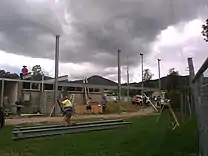
The new clubhouse was built in 2010. Club member and secretary, Julian Smith an architect, prepared the design. Funding for Stage 1, the change rooms, came from the sale of the Tamworth Club. Stage 2 was funded from a $300,000 loan from the National Australia Bank and a $1,000/year contribution from 30 donors for a 3-year period to help offset the interest. The contributors are listed on the wall of the clubhouse.[34]
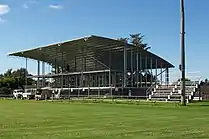
The 2010s saw many of the senior Tamworth teams struggle to keep up with some of the stronger Central North clubs. The under 17s and 19s Tamworth teams were consistently strong and made many finals. Over the decade, many Central North clubs struggled to maintain their juniors.[35]
With the decline in player numbers throughout Central North, Tamworth after a 59-year absence, rejoined the New England Rugby Union in 2018.[36]
Though numerically smaller than Central North, the New England Rugby Union's strength was the depth of teams within their clubs. The large contingent of university students meant that four grade games were played when any of the Armidale and university clubs met whereas the Central North clubs could only muster two teams per club. Even then, some of the smaller clubs battled to raise a reserve grade team. In contrast, the city of Tamworth continued to grow and the club found it a challenge to find games for the growing numbers at training.
The 2018 competition included Armidale Blues RUFC, Barbarian RUFC, St Alberts College RUFC, Robb College RUFC and Glen Innes RUFC.
The move to New England saw the establishment of the club's first women's team. Many of the players were new to rugby and the first year was an erratic one with varying numbers travelling for away games. Eventually, Blake Hamilton and Natasha Field came forward and accepted the challenge and the women's team has become a strong part of the club.
The club's initial success in the New England zone came in 2019 when the Fourth grade side took out the premiership jointly with the St Alberts College side. The game did not have provision for extended play. As the score was tied, both teams shared the accolade. Unfortunately the Third grade side went down to the strong Glen Innes team who played their sole team in the lower grades though they would have given any of the higher grade teams a run for their money.
The 2020 season
The 2020 season looked set to be a good one. Pre-season training numbers were strong with up to 70 players of both sexes turning out in hot weather to train at Viaduct Oval. The club has a long affinity to this ground. Being located across the road from Rugby Park, the Tamworth club often used the space for training and pre-game warm-ups. In the early days of the Friday night juniors competition, the ground had a couple of fields in operation for the primary section of the competition. The lights erected at the ground were paid for by the club in the mid 1990s when Wally Franklin was club president and Pat Lonergan was club secretary. These gentleman and others such as Ken Pulley started the Friday night competition. For the long time, Lyons Barnett Kennedy sponsored the junior competition. With ex-players such as Brian Thompson and David Cummings as partners, it is not hard to appreciate the assistance firms such as LBK provided to grow the game.
As previously stated, the 2020 season had a promising start. Then, in March 2020, the Corona Virus pandemic, commonly referred to as COVID-19, put an end to all sport, business and educational activity. Hospitals prepared for the expected deluge of patients. Fortunately, Australia's distance from world centres and good management minimised the expected number of infections and deaths. There were outbreaks as a result of returning overseas travellers and community transmission which severely hit vulnerable residents of retirement homes but not as severe as experienced in countries such as Italy, the United Kingdom and the USA.
The direct impact on the club was severe. Long-term sponsors suffered as a result of the economic downturn and players lost their jobs. Bank interest repayment terms had to be re-negotiated. Severe saving measures implemented. Income had already decreased. The drought had curtailed the 2019 Summer 7s competition and the 2020 Country Music camping was reduced due to additional establishment costs. Sport was the last thing on people's minds. Everyone worried what the future held and how long the pandemic would last. It was the 1919 pneumonic influenza or Spanish Flu that provided the last example when returning soldiers brought the virus to Australia. Hygiene measures, including mask-wearing, contributed to the decline of the Spanish Flu.
In 2020, to minimise transmission of COVID-19, people had to keep their distance by not exchanging physical greetings and to stay at least 1.5m away from others. This was impossible on the rugby field, but the health authorities determined that both the community's social well-being and the player's health and mental well-being outweighed the risk of transmission between young players who were less susceptible to being infected by the virus.
The COVID restrictions meant that each club could only host 500 players, spectators and officials. In addition the Tamworth club, as others, had to ensure hygiene measures were in place with attendees’ names being recorded, everyone being seated and family groups maintaining 1.5m separation, except for family groups.
The measures proved effective and sport was able to return in July 2020. Some codes and zones still decided the risk was too great and suspended their competitions. The Central North Rugby Union, Group 4 Rugby League and Group 19 Rugby League all shut down whilst the Soccer and Australian Rules bodies decided to play-on. The Tamworth club was the only club in the region playing rugby of either code. Hence media interest was high and raised the profile of the game. However, public scrutiny was also high and the club had to exhibit the highest standards of ground management and behaviour.
The New England Rugby Union, unbeknown to the other bodies, had decided to play a shortened season and were surprised with the decisions of their kindred bodies. The government restrictions were softening and the NERU executive believed the risks were manageable. The NERU competition, which had traditionally relied on the residential students at the University of New England, welcomed an influx of teams and clubs from the Mid-North Coast and Central North Rugby Unions. Glen Innes went from a single team in third grade in 2019 to being able to field three men's teams and a women's 7s team. Many of their players came from the Inverell district who could not play with their local club which played in the Central North competition. It also welcomed some players from rugby league.
The Walcha Rugby Club lodged a request to play in the New England Rugby Union. Like Tamworth, Walcha had once participated in the New England competition and had won the 1953 premiership.
The UNE clubs of St Alberts College and Robb College, who had played in the 2019 grand final, were weakened considerably. With the cancellation of lectures, many students had returned to their home districts and continue their studies by distance. With the easing of restrictions, some students were able to return but not to the extent that allowed the college clubs to reach their strengths of previous years. Even the Armidale Blues and Barbarians clubs were affected by the lack of students. Eventually the Blues, Albies and Baa Baas clubs were able to provide three men's teams and a women's team whilst the Robb club fielded two men's teams in first and second grade only.
The draw was set with a bye when a surprise request was received two weeks prior to the start of the New England competition. The two Coffs Harbour clubs, the Marlins and the Snappers, both asked to join. Their kindred clubs in the Mid-North Coast competition had decided to suspend their season and a request to join the Far-North Coast competition had failed. The NERU had locked in the dates so revising the draw was not an option. It was suggested that the two clubs join the competition as a single entity and fill the bye. So the Harbour Knights was formed in the record time of two weeks providing three mens grades in the shortened seven- week competition.
The Walcha and the Harbour Knights clubs were to prove to be tough opposition providing the match of the round when the Walcha Club travelled to Coffs Harbour. Their livestream commentator stated he could understand how a town of 3000 people could produce such a good rugby team.
The COVID restrictions meant that each club could only host 500 players, spectators and officials. In addition the Tamworth club, as others, had to ensure hygiene measures were in place with attendees’ names being recorded, everyone being seated and family groups maintaining 1.5m separation. Many elderly supporters, expressed concern that their high-risk classification precluded their attendance at games. The club decided it should livestream all games so isolated supporters could watch the games. Folmac TV took on the extra work to make it happen. Two of the three commentators, Mick Schmiedel and Ray McCoy, had rugby league backgrounds so struggled with the rules but brought their media experience. Fortunately Glenn Rose was the expert having played rugby in Sydney. Games had previously been videoed but livestreaming became possible when a broadband connection was made to the club in 2019.
Livestreaming unwittingly provided the families of the club's growing Fijian contingent with the ability to connect with their sons. Most of the players came to Tamworth from villages scattered around Fiji with work visas to work at the local Teys Abattoir. Their wages were remitted back to their families, hence they often went without to ensure their families’ situation improved. Many had never experienced cold weather so the club's hoodies and jackets became hot items for the boys when the winter chills struck the Rugby Club.
2020 proved to be a successful year with the Second and Third grade teams winning their respective premierships. The co-coached Phil Cook and Damian Henry Third grade side were undefeated minor premiers and contained club stalwarts such as Ben Coombes, Jacob Shaw, Nick Bradbery and Michael Pearce. The Andrew Jack Second grade side played some of the smartest rugby of the competition in any grade. Andrew, in this first year at the club, brought a new style of play that the team embraced towards the part of the season that mattered.
In first grade, the old combination of Joe Goldsworthy and Michael Bird had returned and provided assistance to incumbent coach Peter Burke. Together they moulded an eclectic mix of players new to Tamworth and to the code. Rugby league players Scott Blanch, Richard Clegg, Jeremy York and Tex Lagimiri had come to the club from the North Tamworth Bears Rugby League club. Most had played some rugby but it still took time for the combinations to be developed and made to work. The First grade side had finished second on the ladder but had failed to overcome the powerful Walcha side in the preliminary semi final who advanced to the grand final. The following week saw a brave effort by the injury hit team go down to an efficient Harbour Knights outfit who provided tough opposition to the Walcha team. Eventually Walcha defeated the Knights team to win the First grade premiership at Scully Park. Traditionally the home of rugby league, Scully Park was the only ground in the New England capable of holding more than 500 people. The ground's 10,000 capacity was reduced to 1,800 with all tickets sold out as soon as they went on sale. The 2019 grand final at Bellevue Oval at UNE had attracted 1500 people. With the lack of rugby of all forms in the district, interest in the grand final day went beyond expectation. It has been suggested that the number attending could have been doubled.
The club's finances remained viable through the introduction of a new category of perpetual membership. Many supporters paid $250 to become perpetual members including life members. This influx of funds enable the club to function until the season commenced. Fortuitously many sponsors were able to support the club as economic conditions improved. The club decided it should support those businesses who found themselves in difficulty. Their signs remained on the fence and they were invited to attend club events. The club executive believed it was important to show support to those who had support the club in the past. This also included the players. With advice from Headspace, the club used its social media platform to broadcast interviews with players, sponsors and older members about their relationship with the club and how it had helped them. Women's co-coach and long term player Blake Hamilton threw himself into the role of interviewer and provided a solid connection during the dark shut-down period.
Premierships
- First grade premierships: 1956 (New England), 1959 (Central North), 1960, 1963, 1969, 1991, 1993, 1994 and 1996.
- Reserve grade premierships (Central North): 1966, 1972, 1989, 1991, 1993.
- Third grade: NERU: 2020.
- Fourth grade: NERU: 2019 (joint with St Alberts College).
- Under 19s (Central North): 1982, 1983, 1990, 2005, 2007 and 2011.
- Under 17s (Central North): 2002, 2005, 2007, 2009, 2010 and 2011.
- Club champions (Central North): 1993, 1994 and 1996. NERU: 2020.
Coaches and Officials
Notable coaches over the history of the club include:
- Ian Sinclair coached the First Grade team to the 1955 NERU premiership. Ian went onto be a successful Member of New England in the Commonwealth parliament.
- Wally Franklin coached the 1989 "Super Squad" reserve grade to a CNRU premiership followed by success as club President during the club's golden period of the 1990s.
- Joe Goldsworthy and Michael Bird coached the CNRU premiership sides of the 1990s. They also went onto to become coaches for NSW Country.
- Chris Collins and Micheal (Dick) Leonard coached many Under 17s sides to premierships during the 2000s.
- Retired Wallaby and Barraba local Tom Bowman coached First Grade in the 2000s.
- Chris Zucker went onto become President of the CNRU, president of the NSWCRU, NSW Rugby board member and ARU board member.
Our Representatives
1902 S Allen - New England, Combined Country and NSW
1895-99 W Abbott - New England
1901 L Bice - New England
1900 A Borthwick - New England
1899 F Brierly - New England
1912 CJ Britten - New England
1902 R Claude - New England
1901 J Farquharson - New England, Combined Country
1904 W Fulljames - New England
1912 W Goldbold - New England
1904 D Gray - New England
1907 F Griffin - New England
1904 L Hartley - New England
1902-04 W Jones - New England
1899-1901 A McLeod - New England
1900-01 M Ryan - New England, Combined Country (1901)
1901 R Ryan - New England
1904 J Schofield - New England
1900-01 W Stevens - New England
1896 A Thibault - New England
1904 F Veness - New England
1975 Brian Mansfield - NSW, Australia
1990s Bernard Klasen, Adrian Klasen, Dan Whale
2019 Nick Wiseman, Alex Barrett, Blake Clout, Darcy Barker and Cooper Thompson - New England
Life Members
| Year | Name | Year | Name | |
|---|---|---|---|---|
| 1959 | M Power | 1967 | Peter Pulley | |
| 1967 | S Blake | 1971 | DA Ashford | |
| 1972 | John M. Lyons | 1973 | John Boschetti | |
| 1974 | Brian J Thompson | 1975 | D Fraser | |
| 1977 | Ken Noble | 1979 | J Kennedy | |
| 1981 | W.(Bill) Mullens | 1984 | W Muir | |
| 1986 | David Paul | 1987 | Bruce N Treloar | |
| 1987 | Vince Symons | 1990 | R.Alister Fenwicke | |
| 1990 | Chris Collins | 1990 | Barry F Rumble | |
| 1991 | Steve J Moroney | 1991 | Bob Locke | |
| 1998 | Wally Franklin | 1998 | Pat Lonergan | |
| 2002 | Mike Toohey | 2005 | Peter Burke | |
| 2010 | Bill Feggans | 2011 | Joe Goldsworthy | |
| 2011 | Michael Bird | 2013 | Campbell McIntosh | |
| 2013 | Naree McIntosh |
Office Bearers
| Year | President | Secretary | Treasurer |
|---|---|---|---|
| 1954 | E.R. Jeffries | Doug Campbell | F.Dane |
| 1955 | E.R. Jeffries | Doug Campbell | F.Dane |
| 1956 | Doug Campbell | F.Dane | R.Varley |
| 1957 | Dr B.T.Martin | F.Dane | R.Rabone |
| 1958 | G.Alex.Wiseman | W.Smythe | E.Carter |
| 1959 | G.Alex.Wiseman | A. (Tony) Oliver | E.Carter |
| 1960 | G.Alex.Wiseman | Bruce Hyson | J.French |
| 1961 | A. (Tony) Oliver | A. (Tony) Oliver | J.B.Knight |
| 1962 | C.G. Graham | R.Bowen-Thomas | J.B.Knight |
| 1963 | C.G. Graham | G.Hilder | J.B.Knight |
| 1964 | S.Blake | Fred Benecke | J.B.Knight |
| 1965 | S.Blake | Fred Benecke | J.B.Knight |
| 1966 | S.Blake | Fred Benecke | J.B.Knight |
| 1967 | Fred Benecke | John Lyons | Bruce Stewart |
| 1968 | P. Henry | Brian J. Thompson | A Ashford |
| 1969 | John M.Lyons | Brian J. Thompson | G Thomas |
| 1970 | John M.Lyons | Brian J. Thompson | A Ashford |
| 1971 | John M.Lyons | Brian J. Thompson | D Keech |
| 1972 | Brian J. Thompson | R Campbell | K Turner |
| 1973 | Brian J. Thompson | D McGroder/R McGaffin | K Turner |
| 1974 | Brian J. Thompson | W.S. Dockrill | R McGaffin |
| 1975 | Brian J. Thompson | W.S. Dockrill | N O’Reilly |
| 1976 | Ken Noble | David Clifton | S.Bates |
| 1977 | Ken Noble | David Clifton | Bill Mullens |
| 1978 | Bill Mullens | John Treloar | Bob Locke |
| 1979 | B Smith | Stephen Hall | Bob Locke |
| 1980 | David Clifton | Stephen Hall | D. Ashford |
| 1981 | David Clifton | D. Ashford | R.A(Alister).C.Fenwicke |
| 1982 | Tom Woolaston | M.F.Hall | R.A(Alister).C.Fenwicke |
| 1983 | Tom Woolaston | R.Pearson | A. Hardy |
| 1984 | Bruce Treloar | Chris Zucker | A. Hardy |
| 1985 | Bruce Treloar | Chris Zucker | Phil Bolton |
| 1986 | Bruce Treloar | Gordon Magann | Phil Bolton |
| 1987 | Barry Rumble | Gordon Magann | David Cumming |
| 1988 | Barry Rumble | Bob Messer | David Cumming |
| 1989 | Ken Hunt | Bob Messer | David Cumming |
| 1990 | Ken Hunt | Steve Moroney | K Kellahan |
| 1991 | Ken Hunt | Steve Moroney | Bob Messer |
| 1992 | Wally Franklin | Pat Lonergan | Ken Pulley |
| 1993 | Wally Franklin | Pat Lonergan | Ken Pulley/Bob Locke |
| 1994 | Wally Franklin | Pat Lonergan | Bob Locke |
| 1995 | Wally Franklin | Pat Lonergan | Bob Locke |
| 1996 | Wally Franklin | Pat Lonergan | Jane Lonergan |
| 1997 | Steve Snell | P Mounter | Julian Smith |
| 1998 | Vince Symons | B Donnelly | Julian Smith |
| 1999 | Vince Symons | Julian Smith | Warren Cullen |
| 2000 | Vince Symons | Julian Smith | Warren Cullen |
| 2001 | Peter Burke | Adrian Walsh | Warren Cullen |
| 2002 | Peter Burke | Adrian Walsh | Jackie Oriel |
| 2003 | Peter Burke | Adrian Walsh | Peter Burke/Vince Symons |
| 2004 | Peter Burke | Adrian Walsh | David Rodgers |
| 2005 | Nathan Schofield | Mandi Carey | Sean Thompson |
| 2006 | Nathan Schofield | Mandi Carey | Sean Thompson |
| 2007 | Micheal (Dick) Leonard | Mandi Carey | K Laurie |
| 2008 | Micheal (Dick) Leonard | Mitchel Hanlon | Chad Secombe |
| 2009 | Campbell McIntosh | Mitchel Hanlon | John Eggins |
| 2010 | Campbell McIntosh | Mitchel Hanlon | John Eggins |
| 2011 | Campbell McIntosh | Mitchel Hanlon/Mike Penman | Sam Scott/Erin Scott |
| 2012 | Campbell McIntosh | Mike Penman | Sam Scott |
| 2013 | Sam Scott | Clint Coles | Sam Treloar |
| 2014 | Sam Scott | Clint Coles | Sam Treloar |
| 2015 | Sam Scott | James Lockwood | Simon Groth |
| 2016 | Sam Scott | Damian Henry | Simon Groth |
| 2017 | Sam Scott | Damian Henry | Simon Groth |
| 2018 | Mitchel Hanlon | Kim Newling/Geoff Ellerton | Michael O'Connor |
| 2019 | Mitchel Hanlon | Geoff Ellerton | Michael O'Connor |
| 2020 | Mitchel Hanlon | Geoff Ellerton | Michael O'Connor |
See also
- List of rugby union clubs in Australia
- New South Wales Country Rugby Union#New England Rugby Union
- https://www.tamworthrugby.com.au/
- John Evans Hughes 1982, Formation and Early History of the New England Rugby Union, Research Thesis, University of New England.
- Croker, G. 1994, Memories from Scrum and Ruck. A history of the Walcha Rugby Union Football Club, ISBN 0 646 18608 6.
References
- "Football". Maitland Mercury and Hunter River General Advertiser (NSW : 1843 - 1893). 1880-05-01. p. 15. Retrieved 2018-05-29.
- SOUTHERN RUGBY FOOTBALL UNION,The Sydney Mail and New South Wales Advertiser, 8 May 1880, p875 https://trove.nla.gov.au/newspaper/article/161877188?searchTerm=Tamworth
- "FOOTBALL". Sydney Morning Herald (NSW : 1842 - 1954). 1881-05-03. p. 6. Retrieved 2018-05-29.
- "SOUTHERN RUGBY FOOTBALL UNION". Sydney Mail and New South Wales Advertiser (NSW : 1871 - 1912). 1882-05-13. p. 754. Retrieved 2018-05-29.
- http://nla.gov.au/nla.news-article192877105
- "NEWCASTLE FOOTBALL CLUB". Newcastle Morning Herald and Miners' Advocate (NSW : 1876 - 1954). 1891-03-21. p. 7. Retrieved 2018-06-12.
- "Football". Australian Town and Country Journal (Sydney, NSW : 1870 - 1907). 1891-08-15. p. 39. Retrieved 2018-06-12.
- "FOOTBALL". Newcastle Morning Herald and Miners' Advocate (NSW : 1876 - 1954). 1893-06-22. p. 3. Retrieved 2018-06-12.
- "FOOTBALL". Armidale Express and New England General Advertiser (NSW : 1856 - 1861; 1863 - 1889; 1891 - 1954). 1892-06-28. p. 4. Retrieved 2018-06-12.
- "NEWS OF THE DAY". Armidale Express and New England General Advertiser (NSW : 1856 - 1861; 1863 - 1889; 1891 - 1954). 1892-07-26. p. 4. Retrieved 2018-06-12.
- "NEWS OF THE DAY". Armidale Express and New England General Advertiser (NSW : 1856 - 1861; 1863 - 1889; 1891 - 1954). 1893-03-07. p. 4. Retrieved 2018-06-12.
- "RUGBY FOOTBALL". Newcastle Morning Herald and Miners' Advocate (NSW : 1876 - 1954). 1894-08-03. p. 8. Retrieved 2018-06-12.
- John Evan Hughes, 1982, Formation and Early History of the New England Rugby Union, Thesis submitted to the Dept of History of the University of New England.
- "Notes on Sport". Manilla Express (NSW : 1899 - 1954). 1900-04-14. p. 2. Retrieved 2018-05-29.
- "FOOTBALL". Referee (Sydney, NSW : 1886 - 1939). 1903-05-27. p. 8. Retrieved 2018-05-29.
- Scone Advocate, 6 Nov 1904, p3, TROVE accessed 20 Dec 2020
- The Murrurundi Times and Liverpool Plains Gazette, 30 Sept 1905, p2
- "Union Football". Tamworth Daily Observer (NSW : 1910 - 1916). 1912-09-21. p. 6. Retrieved 2018-05-29.
- "LEAGUE FOOTBALL IN TAMWORTH". Tamworth Daily Observer (NSW : 1910 - 1916). 1911-07-18. p. 2. Retrieved 2018-05-29.
- "C.N.R. FOOTBALL UNION". Tamworth Daily Observer (NSW : 1910 - 1916). 1911-07-25. p. 2. Retrieved 2018-05-29.
- "RUGBY UNION FOOTBALL". Tamworth Daily Observer (NSW : 1910 - 1916). 1914-03-31. p. 2. Retrieved 2018-05-29.
- "TAMWORTH UNION FOOTBALL". Tamworth Daily Observer (NSW : 1910 - 1916). 1916-06-17. p. 2. Retrieved 2018-05-29.
- "TAMWORTH UNION FOOTBALL". Tamworth Daily Observer (NSW : 1910 - 1916). 1916-06-27. p. 2. Retrieved 2018-05-29.
- "INTER-DISTRICT FOOTBALL". Tamworth Daily Observer (NSW : 1910 - 1916). 1916-08-14. p. 3. Retrieved 2018-05-29.
- "Sporting Notes". Armidale Chronicle (NSW : 1894 - 1929). 1919-03-26. p. 2. Retrieved 2018-05-29.
- Doug Campbell 2009 pers.comm.
- "The Armidale Express and New England General Advertiser". TROVE. 15 Feb 1952.
- "The Armidale Express and New England General Advertiser". TROVE. Retrieved 12 Dec 2020.
- Croker, G. 1994, Memories from Scrum and Ruck. A history of the Walcha Rugby Union Football Club, ISBN 0 646 18608 6
- "Fiji's Easy Win At Tamworth". Sydney Morning Herald (NSW : 1842 - 1954). 1954-06-10. p. 12. Retrieved 2018-06-12.
- "LIONS BEAT COUNTRY 27 TO 14". Canberra Times (ACT : 1926 - 1995). 1959-06-10. p. 24. Retrieved 2018-06-12.
- "The Fijians are Going to Tamworth". Western Herald (Bourke, NSW : 1887 - 1970). 1969-07-18. p. 11. Retrieved 2018-06-12.
- Vince Symons 2009 pers.comm.
- Mitchel Hanlon, per.comm.,2009
- Mitchel Hanlon, per.comm.,2018
- https://www.northerndailyleader.com.au/story/5222426/tamworth-magpies-rugby-club-align-with-new-england-rugby-union/
- Designs, David Carse - Waterfall Way. "CNRU - Premiers - Bush Rugby in Central Northern NSW". www.cnru.com.au. Retrieved 2018-05-29.